Paul Gilster's Blog, page 162
December 30, 2015
‘Time Delays’ and Exploding Stars
With our focus on nearby stars for both exoplanet detection and SETI work, I don’t often find the time to talk about cosmology and ‘deep sky’ observations, although galaxy structure and formation are an interest of mine. But today I have a story too good to pass up, involving using gravitational lensing and time delays in how light reaches us to investigate events at the edge of the visible universe. In such work, the curvature of spacetime itself is part of our toolkit.
Consider four images found around a foreground galaxy that were created by a background supernova. Here celestial alignments lead us to successful prediction, and for the first time, a supernova appears where astronomers have said it would. Or I should say, ‘re-appears.’
The elliptical galaxy in question is located within the galaxy cluster MACS J1149+2223, which since 2012 has been known to lie between us and a background galaxy whose light is being magnified by the lens of the cluster. In November of 2014, astronomers found four separate images of a supernova from this background galaxy, appearing in the form of a so-called Einstein Cross. Have a look at the image below, where the cross-shaped pattern is clear.
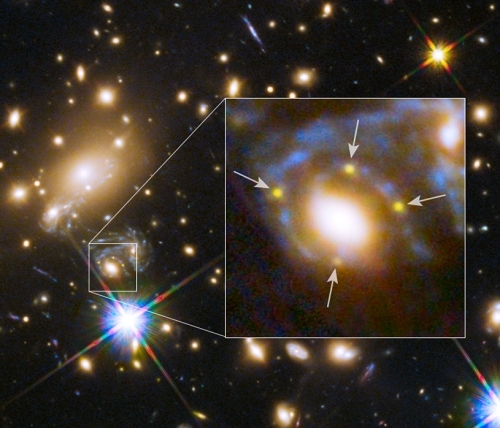
Image: The galaxy cluster MACS J1149+2223. Four images of the same supernova are apparent in the inset image. Credit: NASA, ESA, S. Rodney (John Hopkins University, USA) and the FrontierSN team; T. Treu (University of California Los Angeles, USA), P. Kelly (University of California Berkeley, USA) and the GLASS team; J. Lotz (STScI) and the Frontier Fields team; M. Postman (STScI) and the CLASH team; and Z. Levay (STScI).
Now we have word that on December 11 of this year, a team of astronomers successfully predicted a fifth appearance of the supernova. Of course, the supernova event can occur but once, but we are seeing multiple images whose light has in each case taken a different path to reach us, affected by visible and dark matter in the intervening cluster. This means the images from the background galaxy are somewhat out of synch. A team of astronomers involved in the Grism Lens Amplified Survey from Space (GLASS) and a team from another project called Frontier Fields has been able to model these lensing events with great accuracy.
Tommaso Treu (UCLA) is lead author of one of two papers on this work, which looks at the details of the modeling:
“We used seven different models of the cluster to calculate when and where the supernova was going to appear in the future. It was a huge effort from the community to gather the necessary input data using Hubble, VLT-MUSE, and Keck and to construct the lens models. And remarkably all seven models predicted approximately the same time frame for when the new image of the exploding star would appear.”
The supernova is nicknamed Refsdal, a reference to the Norwegian astronomer Sjur Refsdal, who discussed using time-delayed images from a lensed supernova back in the 1960s. Refsdal believed that such images could be a useful tool for studying the universe’s expansion.
Supernova Refsdal turned up exactly when the astronomers had predicted. Hubble has been at work on MACS J1149 since the end of October, making a series of periodic observations by way of testing the models. The model predicting the supernova’s reappearance was also based on data drawn from the Multi Unit Spectroscopic Explorer (MUSE), attached to ESO’s Very Large Telescope (VLT) at Paranal. This November 25 ESO announcement highlights the prediction, which described the supernova’s brightness as well as its timing and location.
The paper on the supernova’s reappearance points out that despite Refsdal’s early paper, a gravitationally lensed supernova with multiple resolved images was not found in the subsequent five decades (although several individual images have been found with magnification caused by lensing). But astronomers have been able to work on time delays within lensed systems by studying multiply imaged quasars, an effort that has been going on since the 1970s. The ‘reappearance’ paper draws two conclusions about the result of the supernova study:
First, SN Refsdal indeed reappeared approximately as predicted, implying that the unknown systematic uncertainties are not substantially larger than the random uncertainties, at least for some models. This is a remarkable and powerful validation of the model predictions specifically and of general relativity indirectly.
And now that we have a successful prediction, we can start to apply its lessons to the modeling process going forward:
The second conclusion is that already this first detection provides some discriminatory power: not all models fare equally well. Grillo-g, Oguri-g, Oguri-a, and Sharon-a [referring to earlier studies] appear to be the ones that match the observations most closely. In general most models seem to predict a slightly higher magnification ratio than observed, or shorter delays. A detailed statistical analysis of the agreement between the model predictions and the observations will have to wait for the actual measurement of the magnification and time delays, which will require analysis of the full light curve past its peak during 2016.
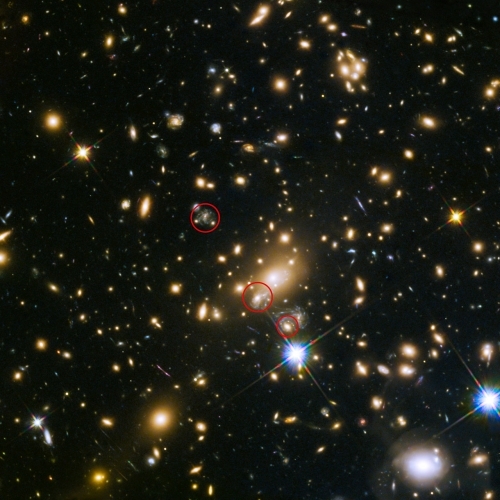
Image: This NASA/ESA Hubble Space Telescope image shows the positions of the past, present and predicted future appearances of the Refsdal supernova behind the galaxy cluster MACS J1149+2223. The uppermost circle shows the position of the supernova as it could have been seen in 1995 (but was not actually observed). The lowermost circle shows the galaxy which lensed the Refsdal Supernova to produce four images — a discovery made in late 2014. The middle circle shows the predicted position of the reappearing supernova in late 2015 or early 2016. Credit: NASA, ESA, S. Rodney (John Hopkins University, USA) and the FrontierSN team; T. Treu (University of California Los Angeles, USA), P. Kelly (University of California Berkeley, USA) and the GLASS team; J. Lotz (STScI) and the Frontier Fields team; M. Postman (STScI) and the CLASH team; and Z. Levay (STScI).
Never before has the appearance of a supernova at a particular time and location in the sky been successfully predicted. We’re now in position to test models involving magnification and time delays for other lensed supernovae. The time delays we see in multiple images of the same event become tools for probing not just the properties of the lensing galaxy and background object, but the properties of cosmic expansion. The fifth image of supernova Refsdal is influenced not only by an individual galaxy but by the gravitational potential of the entire MACS J1149.5+2223 cluster, a reminder of the complexity of the underlying analysis.
The ‘prediction’ paper is Treu et al., “‘Refsdal’ Meets Popper: Comparing Predictions of the Re-appearance of the Multiply Imaged Supernova Behind MACS J1149.5+2223,” in press at The Astrophysical Journal (preprint). The ‘reappearance’ paper is Kelly et al., “Deja Vu All Over Again: The Reappearance of Supernova Refsdal,” submitted to The Astrophysical Journal (preprint).






December 29, 2015
Looking Ahead to OSIRIS-REx
Back when I was in grade school, we put in several months studying ancient Egyptian culture. I can remember becoming fascinated with the pyramid builders and wanting to immerse myself in the world that produced them. But I don’t think I ever reached the multidisciplinary level of a third-grader named Michael Puzio, who named the asteroid now called Bennu. The sharp-eyed Puzio entered a contest to name the asteroid that the OSIRIS-REx mission will fly to, choosing the Egyptian deity Bennu because he thought the spacecraft resembled the mythological bird.

I call Michael Puzio one smart third-grader, and I’m happy that yesterday’s post, on the near-Earth asteroid 2003 SD220, brought him to mind. The close pass by 2003 SD220 on Christmas Eve prompted a series of radar studies that we’ll now use to help refine its orbit. Bennu is likewise nearby, though at about 500 meters a bit smaller than 2003 SD220, and it too has been the object of study by the planetary radars at Arecibo and Goldstone. We also know that Bennu bears watching as a possible future impactor even if the odds seem slight.
To make sure about those odds, it’s necessary to learn a lot more about objects like Bennu so we can see how tiny factors like the Yarkovsky effect may change its trajectory over time. The latter is determined partly by the shape of the asteroid, whose uneven surface and varied composition result in heat from the Sun being unevenly distributed and emitted. A slight push comes from all this, the smallest of nudges, which over time can add up to the kind of trajectory change that could spell the difference between a close call and something worse.
You can imagine how hard all this would be to calculate, but we need to factor the Yarkovsky effect into any potential asteroid mitigation efforts we may someday have to make. That makes measuring the effect and relating it to accurate mapping of the asteroid’s surface a priority.
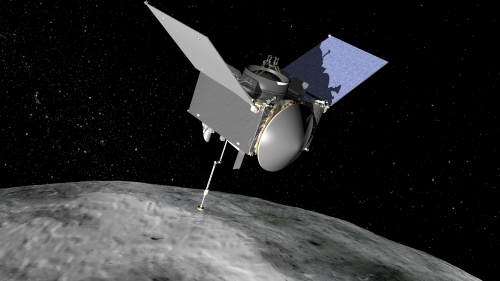
Image: Artist’s conception of the OSIRIS-REx spacecraft during its Touch-and-Go sampling maneuver at Bennu. Credit: NASA/Goddard.
OSIRIS-REx is another of those acronyms that keeps on giving — it stands for Origins Spectral Interpretation Resource Identification Security Regolith Explorer, and pretty much sums up all aspects of the mission that I know about. Launch is planned for September of 2016, with investigation of Bennu by a suite of instruments at the target and a 60-gram sample return. Here we’re trying to learn not only about what such asteroids are made of in case we ever have to nudge one, but also to study materials that may help us understand how water and perhaps organic molecules made their way to the Earth in the early days of the Solar System.
In mid-December, the Canadian Space Agency’s OSIRIS-REx Laser Altimeter (OLA) arrived at Lockheed Martin Space Systems in Denver for integration into the spacecraft. The instrument will produce three-dimensional maps that will help the mission team choose the best site for sample collection. OLA is a LIDAR (Light Detecting and Ranging) system that should tell us much about the asteroid’s topography, surface processes, evolution and overall shape.
Michael Daly (York University, Toronto), instrument lead on OLA, explains its significance (for more, see this OSIRIS-REx news release):
“OLA will measure the shape and topography of Bennu to a much higher fidelity and with much greater efficiency than any planetary science mission has achieved. This information is essential to understanding the evolution and current state of the asteroid. It also provides invaluable information in aid of retrieving a sample of Bennu for return to Earth.”
OSIRIS-REx should reach Bennu in 2018, with sample return scheduled for 2023. The first science data are expected to be returned during an Earth gravity assist in September of 2017. The delivery of OLA complements the July delivery of OVIRS (the OSIRIS-REx Visible and Infrared Spectrometer), which will study spectral signatures from the surface to measure minerals and chemicals at proposed sample sites. All told, five instruments are being integrated into the spacecraft as the system-level environmental testing program proceeds.
It’s all too easy to sensationalize the possibilities of impacts on our planet, but wild-eyed stories in the media don’t negate what common prudence dictates. We must incorporate asteroid mitigation into the rest of our scientific work at near-Earth asteroids. If we never have to use the various technologies that have been discussed for changing an asteroid trajectory, so much the better, but finding out as much as we can about the composition and orbital characteristics of these objects is the sensible way to prepare ourselves for any eventuality. The best insurance is the policy you never have to use.






December 28, 2015
‘Centaurs’ as Potential Impactors
An asteroid shaped something like a sweet potato swept by the Earth on December 24, though at a sufficient distance (28 times further away than the Moon) to pose no hazard to our planet. 2003 SD220 was making the first of five predicted encounters within the next twelve years, and the measurements made by the planetary radar system at Arecibo on the asteroid’s shape, rotation and other properties will now be useful in refining its orbit. The Jet Propulsion Laboratory’s Goldstone Solar System Radar and the National Radio Astronomy Observatory’s Green Bank Telescope and Very Long Baseline Array also contributed data on the asteroid.
Highly elongated and more than 2 kilometers long, 2003 SD220 is of interest as a possible target for a future space mission, not only because asteroids should give us clues about conditions in the early Solar System, but also because near-Earth asteroids need to be well understood in case we one day find ourselves dealing with a potential impactor.
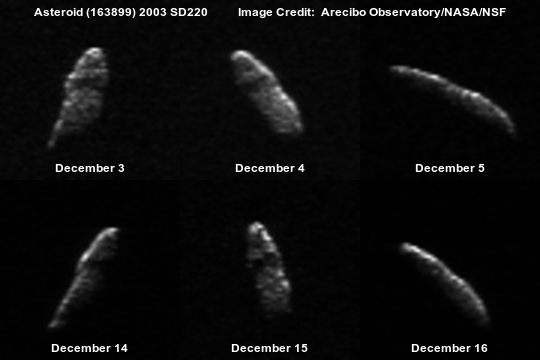
Image: Delay-Doppler image of asteroid 2003 SD220 as observed from the Arecibo Observatory using the NASA-funded planetary radar system on December 3-5 and December 14–15. Credit: Arecibo Observatory.
But as we assess impact probabilities over long periods of time, are asteroids the prime concern? New work out of Armagh Observatory and the University of Buckingham (UK) indicates that we should keep an eye on the outer Solar System, where hundreds of giant comets have been discovered within the last two decades. Known as centaurs, these objects ply unstable orbits that cross the paths of the gas giants. Such encounters can change their trajectories, meaning we need to assess their orbits with care.
The typical centaur is in the 50 to 100 kilometer range — some are larger — with more mass, as this Royal Astronomical Society news release tells us, than the entire population of Earth-crossing asteroids found to date. A centaur deflected onto a trajectory that crosses Earth’s orbit is expected to appear every 40,000 to 100,000 years, according to this work. So while the odds of a direct impact by an intact centaur are slight, these objects are likely to disintegrate as they approach the inner system, with cometary debris posing a potential hazard.
Is cometary dust and debris rather than a single large impact a likely scenario for past extinction events? The paper is currently behind a firewall, but lead author Bill Napier (University of Buckingham) had speculated on the possibility in a paper that appeared earlier this year:
The main asteroid belt seems inadequate to supply the larger impactors, and large cometary populations have now been revealed extending to beyond the planetary system, with the potential to be thrown into the near-Earth environment. The top-heavy mass distribution of these comets, their likely disintegration history when thrown into short-period orbits, and the potential of their debris to cause deleterious effects, make them likely candidates for the mass extinctions observed in the terrestrial record and the associated geological disturbances. The mechanisms involved are a matter for detailed stratigraphic studies; it is suggested here that prolonged atmospheric perturbations arising from fireball storms and dusting are the most energy efficient means of collapsing food chains, yielding both marine and land extinctions.
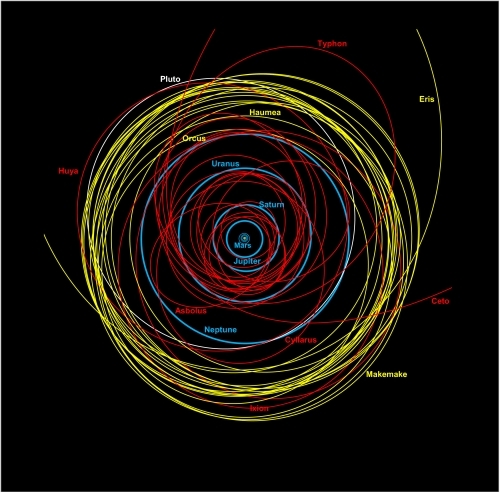
Image: The outer solar system as we now recognise it. At the centre of the map is the Sun, and close to it the tiny orbits of the terrestrial planets (Mercury, Venus, Earth and Mars). Moving outwards and shown in bright blue are the near-circular paths of the giant planets: Jupiter, Saturn, Uranus and Neptune. The orbit of Pluto is shown in white. Staying perpetually beyond Neptune are the trans-Neptunian objects (TNOs), in yellow: seventeen TNO orbits are shown here, with the total discovered population at present being over 1,500. Shown in red are the orbits of 22 Centaurs (out of about 400 known objects), and these are essentially giant comets (most are 50-100 km in size, but some are several hundred km in diameter). Because the Centaurs cross the paths of the major planets, their orbits are unstable: some will eventually be ejected from the solar system, but others will be thrown onto trajectories bringing them inwards. Credit: Duncan Steel.
The image above gives us a sense of how our view of the Solar System has changed over the past century, as we’ve moved from nine planets and an asteroid belt moving through supposedly empty space to a wild jumble of objects including not just asteroids and comets but a vast population of trans-Neptunian objects. You can see how the centaurs cross planetary orbits in the image, and it’s possible that some are captured along the way. Saturn’s moon Phoebe may well have been a centaur that was drawn into Saturn’s gravity well long ago.
Napier puts the new work into perspective:
“In the last three decades we have invested a lot of effort in tracking and analysing the risk of a collision between the Earth and an asteroid. Our work suggests we need to look beyond our immediate neighbourhood too, and look out beyond the orbit of Jupiter to find centaurs. If we are right, then these distant comets could be a serious hazard, and it’s time to understand them better.”
The paper is Napier et al., “Centaurs as a Hazard to Civilization,” Astronomy & Geophysics 56 (6): 6.24-6.30 (abstract). The earlier Napier paper referenced above is “Giant Comets and Mass Extinctions of Life,” Monthly Notices of the Royal Astronomical Society 448 (2015), pp. 27-36 (preprint).






December 24, 2015
Voyager to a Star
The essay that follows is a much expanded version of a brief post that ran here last April, the idea being to give our Voyager spacecraft one last (symbolic) mission. It will run later this year in a publication called ‘Handbook of the Unknowable,’ produced by Espen Gangvik (Director Trondheim Biennale, Norway) and edited by Rachel Armstrong (Newcastle University, UK) and Rolf Hughes (Stockholm University of the Arts). The book will appear in conjunction with Meta.Morf 2016, a recurring Scandinavian festival dedicated to art and technology, which convenes this year in Trondheim. Armstrong, a familiar figure here on Centauri Dreams, tells me that the Handbook will use its essays, poetry, fiction and art to explore our engagement with space and our future among the stars. Meta.Morf 2016 will take place on March 10-11, and I commend both it and the Handbook to you. More on the event as we get closer. Let me also take this opportunity to wish all my readers the very best for the holidays.
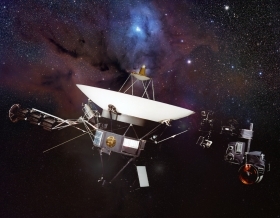
After Voyager 2 flew past Neptune in 1989, much of the world assumed that the story was over, for there were no further planetary encounters possible. But science was not through with the Voyagers then, and it is not through with the Voyagers now. In one sense, they have become a testbed for showing us how long a spacecraft can continue to operate. In a richer sense, they illustrate how an adaptive and curious species can offer future generations the gift of ‘deep time,’ taking its instruments forward into multi-generational missions of interstellar scope.
Now 18.8 billion kilometers from Earth, Voyager 1, which took a much different trajectory than its counterpart by leaving the ecliptic due to its encounter with Saturn’s moon Titan, is 118 times as far from the Sun as the Earth (118 AU). Round trip radio time is over 37 hours. We now believe the craft has left the heliosphere, a ‘bubble’ that is puffed up and shaped by the stream of particles from the Sun called the ‘solar wind.’ Voyager 1 has become our first interstellar spacecraft, and it will keep transmitting until about 2025. Voyager 2, its twin, is currently 109 AU out — 16.4 billion kilometers from the Sun — with a round-trip radio time of over 30 hours.
Throughout history we have filled in the dark places in our knowledge with the products of our imagination, gradually ceding these visions to reality as expeditions crossed oceans and new lands came into view. The Greek historian Plutarch comments that “geographers… crowd into the edges of their maps parts of the world which they do not know about, adding notes in the margin to the effect, that beyond this lies nothing but sandy deserts full of wild beasts, unapproachable bogs, Scythian ice, or a frozen sea…” But deserts get crossed, first by individuals, then by caravans, and frozen seas yield to the explorer with dog-sled and ice-axe.
Voyager and the Long Result
Space is stuffed our imaginings, and despite our telescopes, what we find as we explore continues to surprise us. Voyager showed us unexpected live volcanoes on Jupiter’s moon Io and the billiard ball-smooth surface of Europa, one that seems to conceal an internal ocean. We saw an icy Enceladus, now known to spew geysers, and a smog-shrouded Titan. We found ice volcanoes on Neptune’s moon Triton and a Uranian moon — Miranda — with a geologically tortured surface and a cliff that is the highest known in the Solar System.
But the Voyagers are likewise an encounter with time. The issue raises its head because we are still communicating with spacecraft launched almost forty years ago. I doubt many would have placed a wager on the survival of electronics and internal mechanisms to this point, but these are the very issues raised by our explorations, for we still have trouble pushing any payload up to speeds equalling Voyager 1’s 17.1 kilometers per second. To explore the outer Solar System, and indeed to travel beyond it, is to create journeys measured in decades. With the Voyagers as an example, we may one day learn to harden and upgrade our craft for millennial journeys.
New Horizons took nine years to reach Pluto and its large moon Charon. To reach another star? An unthinkable 70,000 years-plus at Voyager 1 speeds, which is why the propulsion problem looms large as we think about dedicated missions beyond the Solar System. If light itself takes over 18 hours to reach Voyager 1, the nearest star, Proxima Centauri, is a numbing 4.2 light years away. To travel at even a paltry one percent of lightspeed, far beyond our capabilities today, would mean a journey to Proxima Centauri lasting well over four centuries.
What is possible near-term? Ralph McNutt, a veteran aerospace designer at the Johns Hopkins Applied Physics Laboratory, has proposed systems that could take a probe to 1000 AU in less than fifty years, giving us the chance to study the Oort Cloud of comets at what may be its inner edge. Now imagine that system ramped up ten times faster, perhaps boosted by a close pass by the Sun and a coordinated shove from a next-generation engine. Now we can anticipate a probe that could reach the Alpha Centauri stars in about 1400 years. Time begins to curl back on itself — we are talking trip times as great as the distance between the fall of Rome and today.
The interesting star Epsilon Eridani, some 10.5 light years out, would be within our reach in something over three thousand years. Go back that far in human history and you would see Sumerian ziggurats whose star maps faced the sky, as our ancestors confronted the unknown with imagined constellations and traced their destinies through star-based prognostications. The human impulse to explain seems universal, as is the pushing back of frontiers. And if these travel times seem preposterous, they’re worth dwelling on, because they help us see where we are with space technology today, and where we’ll need to be to reach the stars.
A certain humility settles in. While we work to improve propulsion systems, ever mindful that breakthroughs can happen in ways that no one expects, we also have to look at the practicalities of long-haul spaceflight. Both Voyagers have become early test cases in how long a spacecraft can last. They also force us to consider how things last in our own civilization. We have buildings on Earth — the Hagia Sophia in Constantinople, the Pantheon in Rome — that have been maintained for longer than the above Alpha Centauri flight time. A so-called ‘generation ship,’ with crew living and dying aboard the craft, may one day make the journey.
Engagement with deep time is not solely a matter of technology. In the world of business and commerce, our planet boasts abundant examples of companies that have been handed down for centuries within the same family. Construction firm Kongo Gumi, for example, was founded in Osaka in 578, and ended business activity only in 2007, being operated at the end by the 40th generation of the family involved. The Buddhist Shitennoji Temple and many other well known buildings in Japanese history owe much to this ancient firm.
The Japanese experience is instructive. Hoshi Ryokan is an innkeeping company founded in Komatsu in 718 and now operated by the family’s 46th generation. If you’re ever in Komatsu, you can go to a hotel that has been doing business on the site ever since. Nor do we have to stay in Japan. Fonderia Pontificia Marinelli has been making bells in Agnore, Italy since the year 1000, while the firm of Richard de Bas, founded in 1326, continues to make paper in Amvert d’Auvergne, providing its products for the likes of Braque and Picasso.
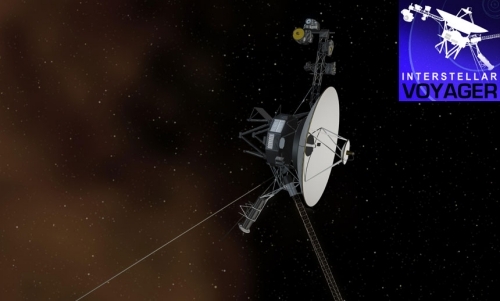
Making Missions that Last
We have long-term thinking in our genes, as the planners of the Pyramids must have assumed. The Long Now Foundation, which studies issues relating to trans-generational thinking and the long-term survival of artifacts, has pointed out that computer code has its own kind of longevity. Enduring like the Sphinx, deeply planted software tools like the Unix kernel may well be operational a thousand years from now. Jon Lomberg and the team behind the One Earth Message — an attempt to transmit a kind of digital ‘Golden Record’ to the New Horizons spacecraft as a catalog of the human condition — estimate that the encoded data will survive at least one hundred thousand years, and perhaps up to a million if given sufficient redundancy.
‘Deep time’ takes us well beyond quarterly stock reports, and even beyond generational boundaries, an odd place to be for a culture that thrives on the slickly fashionable. It’s energizing to know that there is a superstructure that persists. The Voyagers are uniquely capable of keeping this fact in front of us because we see them defying the odds and surviving.
Consider: Only a single instrument on Voyager 1 has broken down since its 1977 launch. Nine other instruments have been powered down on both craft to save critical power resources, but each Voyager has five still-funded experiments and seven that are still delivering data. Stamatios “Tom” Krimigis (JHU/APL) is on record as saying “I suspect it’s going to outlast me.”
Krimigis is one of two principal investigators still on the Voyager mission, out of an original eleven, and the only remaining original member of the Voyager instrument team. His work involves instruments that can measure the flow of charged particles. Such instruments — low-energy charged particle (LECP) detectors — report on the flow of ions, electrons and other charged particles from the solar wind, but because they demanded a 360-degree view, they posed a problem. Voyager had to keep its antenna pointed at the Earth at all times, so the spacecraft couldn’t turn. This meant that the tools needed included an electric motor and a swivel mechanism that could swing back and forth for decades without seizing up in the cold vacuum of space.
The solution was offered by a California company called Schaeffer Magnetics. Krimigis’ team tested the contractor’s four-pound motor, ball bearings and dry lubricant. The company ran the motorized system through half a million ‘steps’ without failure. After more than 5 million steps, the instruments are still working, still detecting a particle flow that is evidently a mix of solar and interstellar particles, one that is moving in a flow perpendicular to the spacecraft’s direction of travel, so that it appears we’re just on the edge of interstellar space, a place where the medium is roiled and frothy, like ocean currents meeting each other and rebounding.
One Last Burn
With the spacecraft now expected to keep transmitting for ten or so more years, we’ll surely see both Voyagers reach true interstellar space before their power runs out. Then the loss of energy will take its toll. Somewhere around 2018 Voyager 1 will shut down its data tape recorder, just as Voyager 2 shuts down its gyros. As instruments go quiet, all power will be shunted to interstellar wind measurements and communications with the distant Earth. As we reach 2020, the few instruments still able to operate by sharing power will be unable to be supported. We’ll be left with only a tracking signal that can last perhaps as late as 2025.
But there is a way to keep the Voyagers alive, if not in equipment then as a part of our lore and our philosophy. They will take about 30,000 years to reach the outer edge of the Oort Cloud (the inner edge, according to current estimates, is maybe 300 years away). Add another 10,000 years and Voyager 1 passes some 100,000 AU past the red dwarf Gliese 445, which happens to be moving toward the Sun and will, by this remote date, be one of the closest stars to the Solar System. As to Voyager 2, it will pass 111,000 AU from Ross 248 in roughly the same time-frame, at which point the red dwarf will actually be the closest star to the Sun.
Carl Sagan and the team working on the Voyager Golden Record wondered whether something could be done about the fact that neither Voyager was headed for another Solar System. Is it possible that toward the end of the Voyagers’ active lifetimes (somewhere in the 2020s), we could set up a trajectory change that would eventually lead Voyager as close as possible to one of these stars? Enough hydrazine is available on each craft that, just before we lose radio contact with them forever, we could give them a final, tank-emptying burn. Tens of thousands of years later, the ancient craft, blind, mute but still more or less intact, would drift in the general vicinity of a star whose inhabitants, if any, might find them and wonder.
A trajectory change would increase only infinitesimally the faint chance that one of these spacecraft would someday be intercepted by another civilization, and neither could return data. But there is something grand in symbolic gestures, magic in the idea that these venerable machines might one day be warmed, however faintly, by the light of another sun. Our spacecraft are our emissaries and the manifestations of our dreams. How we conceive of them through the information they carry helps us gain perspective on ourselves, and shapes the context of our future explorations. Giving the Voyagers one last, hard shove toward a star would speak volumes about our values as a questioning species determined to confront the unknown.





December 23, 2015
Dawn at Ceres: ‘Down Among Them’
The new images just in from Dawn at Ceres unexpectedly evoke a much earlier mission, the Apollo 10 precursor to the lunar landing. This was the second manned mission to orbit the Moon, one that saw the lunar module drop to just over 15 kilometers from the surface in a rehearsal for the Apollo 11 landing. Just for fun, I’ve been looking through the Apollo 10 transcripts for day 5, when the LM (‘Snoopy’) had already separated from the command module.
John Young was in the command module as Gene Cernan and Tom Stafford put Snoopy through its paces. Nobody had ever been this close to the Moon before. You probably remember or else have read about Snoopy’s descent toward the lunar peaks:
100:25:43 Young: …at 6 miles, he was doing 65 feet a second (20 m/s) on my – 6 miles (9.6 km) from me, he was doing 65 feet per second (20 m/s). At 3.8 miles (6.1 km) he was doing 73 feet per second (22 m/s). I think that confirms this burn. They are down there among the rocks…
As Cernan quickly confirmed:
100:26:54 Cernan (in Snoopy): We is Go, and we is down among them, Charlie.
To which capcom Charlie Duke in Houston replied:
100:26:57 Duke: Roger. I hear you weaving your way up the freeway. Can you give me a post-burn report? Over.
And later:
100:44:57 Cernan (in Snoopy): Hey, I tell you, we are low! We are close, babe! This is, like, it! And it really looks pretty smooth down there, surprisingly enough.
Dawn is not a manned mission, but I couldn’t help thinking of those Apollo 10 moments (still vivid in my memory) when I looked at the latest imagery from Ceres. The spacecraft has now descended into its final and lowest orbit at the dwarf planet, which will bring us the highest resolution images we’ll get. Here we are ‘down among them,’ though not nearly as close as Apollo 10 to the Moon. The altitude is approximately 385 kilometers, an altitude that Dawn will maintain for the rest of the mission. The resolution in the image below is 35 meters per pixel.
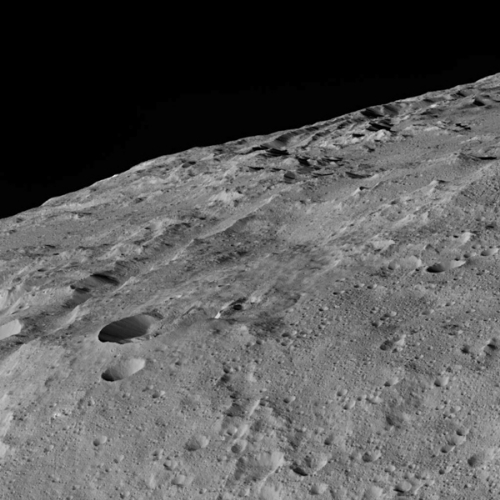
Image: This image of Ceres was taken in Dawn’s low-altitude mapping orbit around a crater chain called Gerber Catena. Credit: NASA/JPL-Caltech/UCLA/MPS/DLR/IDA.
Ceres is a small world, a mere 940 kilometers in diameter, but the trough features are interesting, a common sight on larger planets. They are thought to be the result of impact stresses and contraction, and as this JPL news release points out, may also result from the loading of the crust by large mountains (think Olympus Mons on Mars). Researchers believe similar processes have occurred across Ceres, with some troughs possibly reflecting internal tectonic stresses. “Why they are so prominent is not yet understood,” says Paul Schenk (Lunar and Planetary Institute) but they are probably related to the complex crustal structure of Ceres.”
So bit by bit, we’re working out Ceres’ mysteries. We’ve recently learned that the bright material found in craters like Occator is consistent with hexahydrite, which is a type of magnesium sulfate (see Catching Up with Dawn at Ceres). We’ve also learned that Ceres contains ammoniated clays, which leads to the speculation that it may have formed as far out as the orbit of Neptune and migrated inward, or else later drew in materials that formed there.
We have months of data and imagery ahead. With Dawn’s primary and backup framing cameras both operational, we turn to the craft’s visible and infrared mapping spectrometer, which will identify minerals by analyzing the wavelengths of light reflected off the surface. The abundance of various elements will be measured by the craft’s gamma ray and neutron detector (GRaND). And after operations have ended? Dawn was able to leave Vesta but it will never leave Ceres, its orbit stable enough that it will remain as a satellite of the dwarf planet.
Sometimes I have to remind myself that what I am looking at is real, given that Ceres has been no more than an blurry speck for most of my life. Spaceflight kicks off the grandest of enthusiasms, infusing us with genuine wonder even when we’re in the most demanding of situations. On that note I return briefly to Apollo 10, at the moment during the LM’s descent when the Earth began to rise and highly trained astronauts gave voice to the moment:
100:25:30 Cernan (in Snoopy): Look at that – look at the Earth! Look at the Earth!
[Very excited comments at seeing Earthrise.]
100:25:33 Stafford (in Snoopy): Oh gee. Look at the Earth, John. Get it, get it.
100:25:42 Stafford (in Snoopy): Oh my God, I can’t believe it! It’s just…
I wouldn’t have been able to find the words either. Here’s the image from Snoopy.
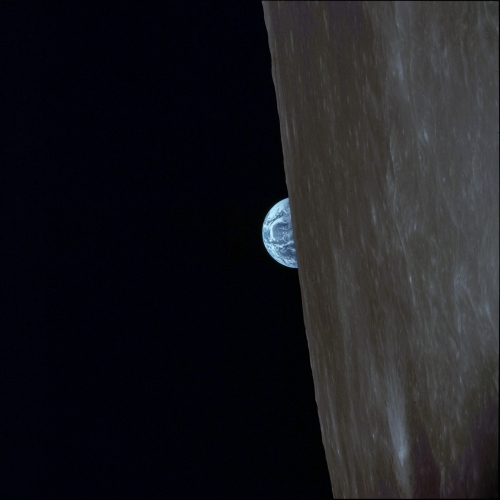






December 22, 2015
Wolf 1061c: A Nearby Habitable Zone Planet?
At no more than 14 light years away, Wolf 1061 gains our attention with the discovery that this small red dwarf hosts three planets, in orbits of 4.9, 17.9 and 67.2 days respectively. Of particular interest is Wolf 1061c, which appears to be within the habitable zone, defined here as the region in which it would be possible for liquid water to exist on the surface, and potentially life. Wolf 1061c has a mass at least 4.3 times that of Earth, with inner planet Wolf 1061b coming in at 1.4 times that mass. Wolf 1061d is calculated to be at least 5.2 times Earth’s mass.
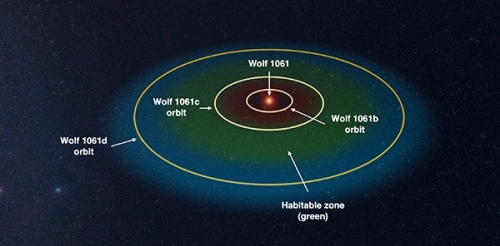
Image: The Wolf 1061 system, with the habitable zone depicted in green. Credit: University of New South Wales.
One thing Wolf 1061 reminds us is that red dwarf stars are good targets for radial velocity studies. For one thing, such stars have low levels of luminosity, which means their habitable zones are small and planets within them are in close orbits. Such planets create a stronger, more detectable signature for instruments using Doppler methods, a fact that is intensified by the typically low mass of the star. The paper on this work adds that M-dwarfs also show sharp molecular absorption features and typically have slow rotation speeds.
The current work, led by Duncan Wright at the University of New South Wales, is based on data from the HARPS spectrograph (High Accuracy Radial Velocity Planet Searcher) installed on the European Southern Observatory’s 3.6m telescope at La Silla. Long-term monitoring data on more than a hundred M-dwarfs is found within the HARPS database. 148 HARPS spectra for Wolf 1061 are available here, taken over a period of 10.3 years. Wright and team have found a more precise way to extract Doppler signals from the HARPS data reduction software (DRS) by creating a custom mask generated from within the data for the star.
The template is, in other words, custom-built for the particular star under study, with details supplied in the paper. For our purposes, the results for the two outer planets stand out. From the paper:
The 17.867 d planet is of particular interest because it is of sufficiently small mass to be rocky and is in the habitable zone of the host M dwarf star. The probable outer planet at 67.274 d resides just on the outer boundary of the habitable zone and is also likely rocky. These planets join the small but growing ranks of potentially habitable rocky worlds orbiting nearby M dwarf stars.
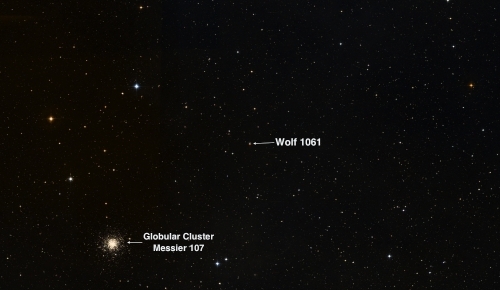
Image: The sky area in the constellation of Ophiucus near the red dwarf star Wolf 1061 which includes the impressive, but unrelated, star cluster Messier 107. Wolf 1061 is 14 light years away. Credit: The “Aladin sky atlas” developed at CDS, Strasbourg Observatory, France.
But we may be able to deploy other tools besides radial velocity, for the paper argues that the strong Doppler signals may be supplemented by transits, considering how short the orbital periods of these planets are. The transit probabilities are listed as 14 percent for planet b, 5.9 percent for planet c, and 2.6 percent for planet d. These would be transits that are detectable from ground-based telescopes given the transit depths the authors estimate, which would make Wolf 1061 an excellent target for projects like MEarth (a robotic observatory on Mt. Hopkins, AZ) and MINERVA (MINiature Exoplanet Radial Velocity Array, also on Mt. Hopkins).
The paper is Wright et al., “Three planets orbiting Wolf 1061,” to be published by The Astrophysical Journal Letters (preprint).






December 21, 2015
Oxygenation: Gradual Process, Profound Results
The vast changes our planet has undergone since formation add a real sense of humility to the exoplanet hunt. It’s the humility that comes with exposure to deep time, reminding us that worlds like ours have developed through phases wildly different than the conditions we experience today. As we tune up our techniques for studying rocky worlds, we’ll find planets in entirely different states of their own evolution, perhaps some with life, and some young enough to be life’s future home. Perhaps some will be worlds where life has come, and gone.
We have much to learn about how our own planet developed life, and new work from an international team led by Philip Pogge von Strandmann (University College London) gives us insight into a key issue: How long did it take for oxygen levels in the oceans and atmosphere to increase to the point that animal life could take off some 600 million years ago? Underlying the question is how the evolution of life ties in to changes in climate. For it seems likely that increased oxygen was the factor that brought about the first major expansion of animal life.
Co-author David Catling (University of Washington) defines the issue this way:
“Oxygen was like a slow fuse to the explosion of animal life. Around 635 Ma, enough oxygen probably existed to support tiny sponges. Then, after 580 Ma, strange creatures, as thin as crêpes, lived on a lightly oxygenated seafloor. Fifty million years later, vertebrate ancestors were gliding through oxygen-rich seawater. Tracking how oxygen increased is the first step towards understanding why it took so long. Ultimately, a grasp of geologic controls on oxygen levels can help us understand whether animal-like life might exist or not on Earth-like planets elsewhere.”

Image: Artist’s conception of a ‘snowball Earth.’ Credit: Neethis / Wikimedia Commons.
The researchers measured selenium isotopes in rock samples laid down under the ocean to track oxygen levels from 770 to 525 million years ago (across the full period believed to be covered by what is known as the Neoproterozoic Oxygenation Event). The marine shales are drawn from seven different geological sections, with samples from Canada (the Mackenzie Mountains), China (the so-called Yangtze Platform), Australia and the western US.
This is a fascinating period because three major glaciation events occurred during it: The Sturtian (‘snowball Earth’) of roughly 716 million years ago, the Marinoan (635 million years ago, or 635Ma), and the Gaskiers glaciation (about 580 Ma).
This would be a planet that looked nothing like what we’re familiar with, as the image above suggests. The land would have been covered in ice and the oceans frozen all the way to the equatorial regions. Temperature changes as these eras progressed would in each case melt the glaciers and produce a flow of nutrients into the oceans, one that would build the levels of organic carbon in seafloor sediments as oceanic plankton that flourished from that flow died. The growth in such carbon would lead to gradual increases in the level of oxygen.
A key finding of the paper is that rather than occurring after the Gaskiers glaciation, the oxygenation began much earlier, during or at the end of the Marinoan glaciation. From the paper:
“…the significance of the Se isotope record is not only that it adds to growing evidence that the late Proterozoic and Cambrian ocean and atmosphere reached a progressively more oxic state, coinciding with the diversification of animal life, but also that the process of oxidation was protracted, and not ultimately triggered by the Gaskiers deglaciation, as other data suggest.”
Moreover, it took approximately 100 million years for atmospheric oxygen to climb from less than 1 percent to over ten percent of today’s level. The occurrence of oxygenation in fits and starts over such a lengthy period of time is evidence, the team believes, that early animal evolution received its needed boost from these increased levels of oxygen. Says Pogge von Strandmann: “We were surprised to see how long it took Earth to produce oxygen and our findings dispel theories that it was a quick process caused by a change in animal behaviour.”
The paper is von Strandmann et al., “Selenium isotope evidence for progressive oxidation of the Neoproterozoic biosphere,” Nature Communications 6, article number 10157, published online 18 December 2015 (full text). A UCL news release is also available.






December 18, 2015
Where Are the Jupiter Analogs?
Are Solar Systems like ours commonplace? One way of answering this is to look at the role of planets like Jupiter, which may have helped to determine the habitability of the inner planets. But worlds like Jupiter in orbits around 5 AU do not appear to be the norm, as Andrew LePage points out in this discussion of a new exoplanet find. LePage, publisher of an essential site on exoplanet detection (www.DrewExMachina.com) is also a Senior Project Scientist at Visidyne, Inc. in Boston. Today he shows us what we know and just how much we still need to clarify about the occurence of planets like Jupiter and their role in system habitability.
By Andrew J. LePage

A couple of decades ago, astronomers thought they had planetary systems figured out: they consisted of a more or less orderly set of worlds orbiting in the same plane with small rocky worlds close in and much larger, volatile-rich planets orbiting farther out beyond the “snow line” where plentiful water freezes into solid ice. Along with this model came the view among some that the presence of large Jupiter-like planets was not only likely but required to deliver water and clear out potential impact hazards to ensure the habitability of smaller rocky worlds orbiting inside a star’s habitable zone. Coupled with the Copernican principle that implies that there is nothing special about our Solar System, it was expected that extrasolar planetary systems would have similar architectures and possess “Jupiter analogs”.
But with the discovery of the first extrasolar planet orbiting a main sequence star back in 1995, this orderly view of planetary systems was called into question. This first exoplanet, 51 Pegasi b, was a Jupiter-mass world in a four-day orbit only 8 million kilometers from its sun. This “hot Jupiter” and a host of other extrasolar giant planets (EGPs) discovered since with a wide range of orbital radii clearly demonstrated that other arrangements of planetary systems are possible and that Jupiter analogs might not be the norm after all. Unfortunately, getting a clear picture of exoplanetary systems has been difficult because of the detection biases of the most often used detection techniques (i.e. precision radial velocity measurements and transit observations) clearly favor finding large planets in small orbits with short periods. But with two (and sometimes more) decades of data from various long-running radial velocity surveys now available for analysis, this is beginning to change as it now becomes possible to detect EGPs with orbital periods of a decade or more.
Earlier this month, the team responsible for Lick-Carnegie Exoplanet Survey announced the latest discovery of a Jupiter analog in a paper accepted for publication in The Astrophysical Journal. What makes this discovery all the more interesting is that the lead author, Dominick Rowan, is a senior at Byram Hills High School in Armonk, New York. Rowan recently won individual top honors in the Regional Finals of the Siemens Competition in Math, Science & Technology as a result of his work described in this paper. The newest Jupiter analog found by Rowan et al. orbits the Sun-like star HD 32963 about 120 light years away. With a mass estimated to be 94% that of the Sun, this star has a luminosity of about 90% of the Sun’s and an estimated age of around five billion years.
To find the new Jupiter analog, designated HD 32963b, a total of 199 radial velocity measurements acquired over 16 years using HIRES (High Resolution Echelle Spectrometer) on the 10-meter Keck I telescope at Mauna Kea, Hawaii were analyzed. These data were placed into two-hour bins to create 109 individual radial velocity measurements with a typical uncertainty of ±1.2 meters/second. A clear signal with a semiamplitude of 11 meters/second and a period of 6.49 years was seen in the data with only a 2×10-5 false alarm probability. This signal indicates the presence of a planet in a nearly circular 3.4 AU orbit – only a touch smaller than Jupiter’s 5.2 AU orbit around the Sun. Since the tilt of the new planet’s orbit with respect to the plane of the sky is not known, only the minimum mass or Mpsini of 0.70 times that of Jupiter (or MJ) can be determined using radial velocity measurements alone. By assuming a randomly oriented orbit, there is less than a one in three chance that HD 32963b is more massive than Jupiter.
Rowan et al. took their analysis one step further and examined the data from the Lick-Carnegie Exoplanet Survey to determine the occurrence rate of Jupiter analogs around Sun-like stars. For the purpose of this analysis, a Jupiter analog was defined as an EGP with a mass in the 0.3 to 3 MJ range orbiting a Sun-like star with an eccentricity less than 0.3 and a period of between 5 to 15 years (which corresponds roughly to orbital radii in the 3 to 6 AU range). The new find by Rowan et al. qualifies as a Jupiter analog by this definition.
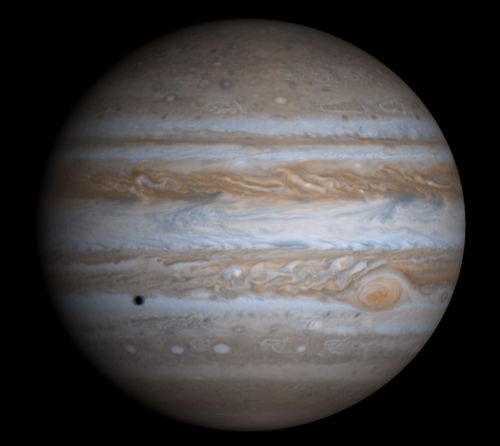
Image: Jupiter dominates our Solar System and may have had a role to play in the habitability of our own planet. We’re only now learning, however, how common such worlds are in orbits comparable to our own Jupiter’s at 5 AU. Credit: NASA/JPL/University of Arizona.
A review of the Exoplanet Data Explorer in August 2015 revealed 21 EGPs that met the working definition for Jupiter analog. Of these, eight published exoplanets that met the baseline requirements were found among the 1,120 Sun-like stars in the Lick-Carnegie Exoplanet Survey, yielding a raw frequency rate of 0.71%. In order to turn this raw number into a meaningful occurrence rate, the detection efficiency of the radial velocity survey for this class of planet must be taken into account. To accomplish that, Rowan et al. created synthetic radial velocity data sets for each star in their survey representing 320,000 different combinations of various planetary mass and orbital parameters. The ability of their analysis algorithms to detect these velocity variations through the noise in the data was then gauged to determine the detection efficiency.
The analysis by Rowan et al. found that the occurrence rate of Jupiter analogs orbiting Sun-like stars as defined here was approximately 3%. Making reasonable assumptions about the possible distribution of EGP properties, the rate can not be less than about 1% nor greater than around 4%. These results roughly agree with earlier studies based on microlensing and long-term radial velocity surveys. This suggests, contrary to earlier expectations, that Jupiter analogs are not common. This finding implies that either planet migration mechanisms from the snow line are very efficient at moving EGPs into smaller orbits or that EGPs have a difficult time forming at distances of about 5 AU.
But before the alarms are sounded by “rare Earth” advocates about the relative rarity of Jupiter analogs, it remains to be seen just how vital Jupiter analogs are to planetary habitability given the spectrum of architectures observed in exoplanet surveys to date. Even if Jupiter analogs prove to be required, current surveys have yet to search effectively for smaller Neptune to Saturn-size worlds at distances of about 5 AU or for EGPs at greater distances which may suffice as “Jupiter surrogates”. Only continued collection of radial velocity data along with new surveys, such as the current Gaia astrometry mission and the new generation of telescopes to image exoplanets directly, will allow us to fill in the missing pieces of our knowledge of exoplanetary systems. Thankfully this ongoing search provides opportunities for aspiring young scientists like Dominick Rowan.
The paper is Rowan et al. “The Lick-Carnegie Exoplanet Survey: HD32963 — A New Jupiter Analog Orbiting a Sun-like Star” accepted for publication in The Astrophysical Journal (preprint).






December 17, 2015
E-22: The Last Hurrah at Enceladus
It’s the end of an era. On Saturday December 19, the Cassini Saturn orbiter will make its final close pass by Enceladus. This doesn’t mark the end of Cassini itself, which still has work to do especially with regard to Titan, but it does mean the end, at least for now, of our close-up study of a remarkable phenomenon: The plumes of Enceladus, which Cassini itself discovered. We’ve gained priceless data through its flybys, helping us make the case for an internal ocean.
Cassini will continue to observe Enceladus until mission’s end, but only from much greater distances. In fact, as this JPL news release explains, the closest Cassini will come to Enceladus after Saturday is about four times the distance of the upcoming flyby. Nor will the Saturday event be as close a pass as Cassini’s dive through the south polar plume on October 28. That one took the spacecraft within a scant 49 kilometers of the surface, returning data that is still undergoing analysis as we probe the plume’s activity. A key issue: Is there hydrogen gas here, which would offer yet more evidence for active hydrothermal systems on the seafloor?
Image: An animation showing the upcoming December 19 flyby of Enceladus, in which Cassini’s composite infrared spectrometer instrument will observe the moon’s south polar terrain. Credit: NASA/JPL.
The Saturday event will be all about measuring the moon’s heat, a critical factor in making sense of the factors driving the spray of particles and gas from the ocean beneath. 5000 kilometers turns out to be about the right distance to allow the best working of Cassini’s Composite Infrared Spectrometer (CIRS) as it maps the heat flow across the southern polar region, according to Mike Flasar, CIRS team lead at NASA GSFC:
“The distance of this flyby is in the sweet spot for us to map the heat coming from within Enceladus — not too close, and not too far away. It allows us to map a good portion of the intriguing south polar region at good resolution.”
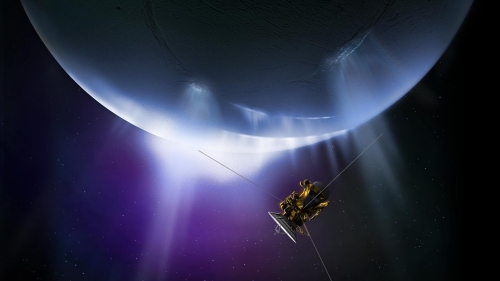
Image: An exciting chapter of space exploration history will come to a close as NASA’s Cassini spacecraft makes its final close flyby of Saturn’s active, ocean-bearing moon Enceladus. The spacecraft is scheduled to fly past the icy moon at a distance of 4,999 kilometers on Dec. 19 at 0949 PST (1749 UTC). Although Cassini will continue to observe Enceladus for the remainder of its mission (through Sept. 2017), its next-closest encounter with the moon will be at a distance more than four times farther away. The focus of the Dec. 19 encounter will be on measuring how much heat is coming through the ice from the moon’s interior — an important consideration for understanding what is driving its surprising geyser activity, which Cassini discovered in 2005. Credit: NASA/JPL-CalTech.
Keep in mind that the south polar region of Enceladus was well lit when Cassini arrived at Saturn in 2004, but at present the area is in winter darkness, making these heat studies that much easier to complete absent the heat of the Sun. By mission’s end, we will have data on six years of winter darkness in the south polar area. The discovery of geologic activity caused the mission’s flight plan to be changed to make Enceladus a prime target of operations. Of all the gifts Cassini has given us, finding a global ocean beneath the ice glitters the most brightly.






December 16, 2015
Naming New Worlds
I can only wonder what Miguel de Cervantes Saavedra would have thought of the idea that a distant star would one day be named for him. I wonder, too, what the Spanish novelist (1547-1616) would have made of the idea that planets circled other stars, and that planets around the star named for him would have names taken from his most famous work, Don Quixote. Maybe the great character of the book’s title, obsessed with tales of chivalry, would have been unhinged enough to take things like other solar systems in stride.

We have the contest to thank for these speculations. The contest, organized by the International Astronomical Union (IAU) gave the public the opportunity to choose the names of selected stars and planets. The star named for Cervantes is mu Arae (HD 160691), a G-class star about fifty light years out in the constellation Ara (the Altar). Here we’ve found three gas giant planets comparable to Jupiter as well as a ‘super-Earth.’ And frankly, as a reader who agrees with Schopenhauer that Don Quixote is one of the world’s great novels, I am delighted with what the public has chosen, at least for this star.
Image: Portrait of Miguel de Cervantes y Saavedra (1547-1615), by the artist Juan de Jauregui y Aguilar (circa 1583-1641). Credit: Bridgeman Art Library.
For mu Arae b becomes Quijote, while mu Arae c is Dulcinea. The system is rounded out with Rocinante (mu Arae d) and Sancho (mu Arae e). Names as enchanting as these, with roots in classic literature, are likely to stick. When the voting finished at the end of October, the IAU had received 573,242 votes, which went toward naming 14 host stars and 31 exoplanets. Names were submitted from astronomy organizations in 45 countries, everything from amateur astronomy clubs to universities and planetariums, drawn from a wild variety of sources.
Take Thestias, the planet depicted in the image below. The grandfather of Pollux, Thestias orbits the star of the same name (Pollux, already named, needs no further designation). In Greek mythology, Pollux and Castor were twin brothers known as the Dioscuri who became transformed at death into the constellation Gemini. The winning name came from SkyNet, an astronomy project based at the International Centre for Radio Astronomy Research (ICRAR) in Perth, Australia. The group, which includes over 200,000 volunteers globally, arrived at the submission by an internal vote, drawing on the idea of volunteer Rich Matthews.
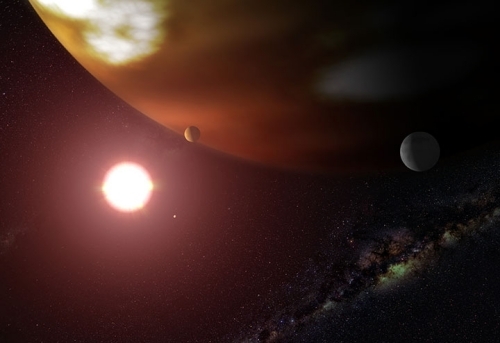
Image: Artist’s impression of Thestias around its star Pollux. Credit: NASA/ESA and G. Bacon (STScI).
If mu Arae taps the late European Renaissance for its inspiration, 47 Ursae Majoris (46 light years out) draws on Thai folklore. The star receives the name Chalawan, while 47 Ursae Majoris b becomes Taphao Thong and 47 Ursae Majoris c is Taphao Kaew, these being two sisters in the story of a mythological crocodile king. The star upsilon Andromedae (an F-class star 44 light years away) becomes Titawin, a point of contact in Morocco between Spaniards and Arabs after the 8th Century. The planets upsilon Andromedae b, c and d become Saffar, Samh and Majriti, names drawn from astronomers and mathematicians notable in 11th Century Spain.
I think some of these names will last, but I’m not at all sure why the IAU chose to put out a call for new names for epsilon Eridani, at 10.5 light years one of the closest stars and a familiar name to generations of science fiction readers. I’m OK with giving epsilon Eridani b the name AEgir, which is drawn from Norse mythology (he was husband to Ran, the goddess of the sea), but changing the star epsilon Eridani to Ran is just not going to work, the original name being too widely circulated. It’s as odd as if we named the three Centauri stars anything other than their designation, the point being that by wide use, the designation and the name are one.
18 Delphini gets tagged Musica (lovely!), while its planet 18 Delphini b is now the wisely chosen Arion, a Greek musician whose tunes attracted the dolphins who saved him at sea. It’s also heartening to see the 55 Cancri planets named for great figures in astronomy including Galileo and Brahe, while the star itself becomes Copernicus. But is Poltergeist going to survive as the name of one of the pulsar planets (PSR 1257+12 c)? How about Spe for 14 Andromedae b?
My cavils aside, I love the idea of pulling the public into the naming of planets because we live in a world undergoing an unprecedented expansion of consciousness skyward. The great voyages of discovery have nothing on what we are doing now, pushing away from Sol to find planets at ever smaller and more Earth-like scale as we begin, in the tiniest way, the process of mapping the planetary systems of a galaxy of 200 billion stars. Ultimately, naming exoplanets will by necessity become an ad hoc process, to be resorted to as needed, because the number of planets will dwarf our lexicons. But we’re still getting used to that idea, and the NameExoWorlds contest has been a delightful way to bring visibility to the question.






Paul Gilster's Blog
- Paul Gilster's profile
- 7 followers




